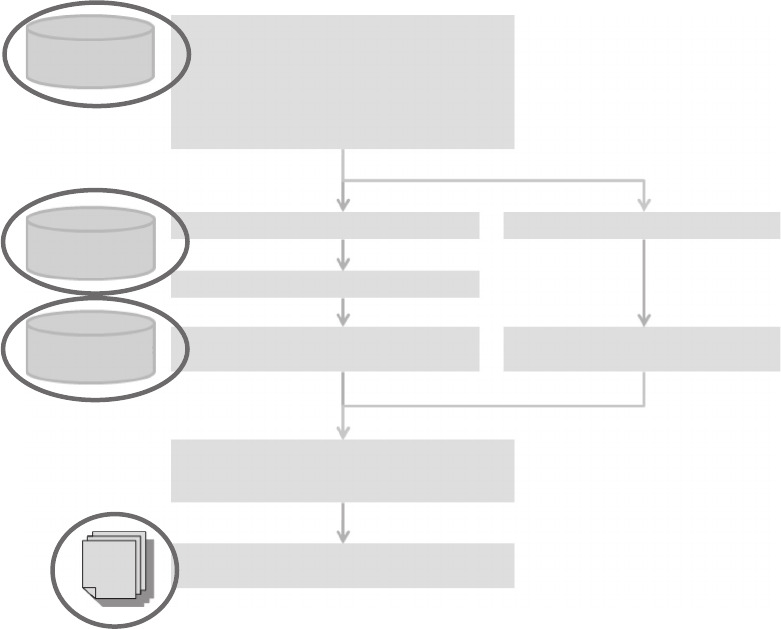
105
8
Data Requirements for Pricing
The actual analysis mostly starts with data, and you will need to have appropriate data to
undertake your risk costing exercise. As Figure 8.1 shows, there are several sources of data
that you will be interested in: some of it will be related to the client* (or prospective client),
and some will be external to the client (such as portfolio or market information).
One reason why it is important to understand what data you need for a pricing exercise
is that you often have to request this data explicitly and make sure it meets certain require-
ments. Alternatively, if you work for an underwriter, you may be in a position to help
dene how a claims/policies management system is to be structured.
8.1 Policies and Cover Data
To start with, we need to collect some basic information on the policies that we are sup-
posed to price. In the case of commercial lines, there may be a single policy, such as the
employers’ liability policy purchased by an organisation. In personal lines, pricing is car-
ried out on a portfolio of policies rather than on each policy in isolation. In reinsurance
treaties, we normally price a single reinsurance policy with an underlying portfolio of
policies underwritten by the reinsured.
Furthermore, policy data is paramount in other exercises apart from pricing, such as the
analysis of the performance of a portfolio.
Regardless of the number of policies we have in the portfolio, this is typically what you
should have for each policy:
• Policy ID
• Policy inception date
• Policy expiry date
• Policy limits and deductibles (individual and aggregate), both current and
historical
• Participation percentage (if the insurer does not underwrite 100% of the risk, but
coinsures the risk with others)
• Relevant exposure
• Rating factors (if applicable)
• Gross premium
• Brokerage fee
*
In practice, client-related data may be kept by the client itself (for example, by its risk management function),
or it might be in the hands of the insurers (both the current insurer and the ones from which the client has
purchased insurance in the past).

106 Pricing in General Insurance
• Type of coverage
• Territories
• Exclusions
In the case of reinsurance, we also need other information such as the policy basis
(claims made, losses occurring and risk attaching), the index clause, the hours clause and
the reinstatements. This will be addressed in more detail in Chapter 20 (Experience rating
for non-proportional reinsurance).
Figure 8.2 shows an example of policy data that has actually been used for the analy-
sis of the performance of a portfolio of nancial institutions policies (mostly professional
indemnity [PI], directors’ and ofcers’ liability [D&O], nancial institutions’ insurance [FI]).
Individual
loss data
Exposure
data
Portfolio/market
information
Adjust historical claim counts for IBNR
Adjust for exposure/profile changes
Select frequency distribution and
calibrate parameters
Adjust loss amounts for IBNER
Select severity distribution and
calibrate parameters
Severity model
Frequency model
Estimate gross aggregate distribution
e.g. Monte Carlo simulation, Fast Fourier
transform, Panjer recursion…
Ceded/retained aggregate loss model
Gross aggregate loss model
Allocate losses between (re)insurer and
(re)insured
Cover
data
Data preparation
– Data checking
– Data cleansing
– Data transformation
– Claims revaluation and currency conversion
– Data summarisation
– Calculation of simple statistics
Inputs to frequency/severity analysis
Assumptions on
– Loss inflation
–
Currency conversion
– …
e Risk Costing Process (Stochastic Modelling)
FIGURE 8.1
Data on different aspects of the risk (losses, exposure, cover and portfolio/market information) enters the pro-
cess at several points. Note that exposure data and portfolio information are used for several of the steps of the
process in frequency and severity modelling. For example, portfolio information can be used for tail model-
ling, frequency benchmarking and incurred-but-not-reported (IBNR) and incurred-but-not-enough-reserved
(IBNER) adjustment.
Get Pricing in General Insurance now with the O’Reilly learning platform.
O’Reilly members experience books, live events, courses curated by job role, and more from O’Reilly and nearly 200 top publishers.

